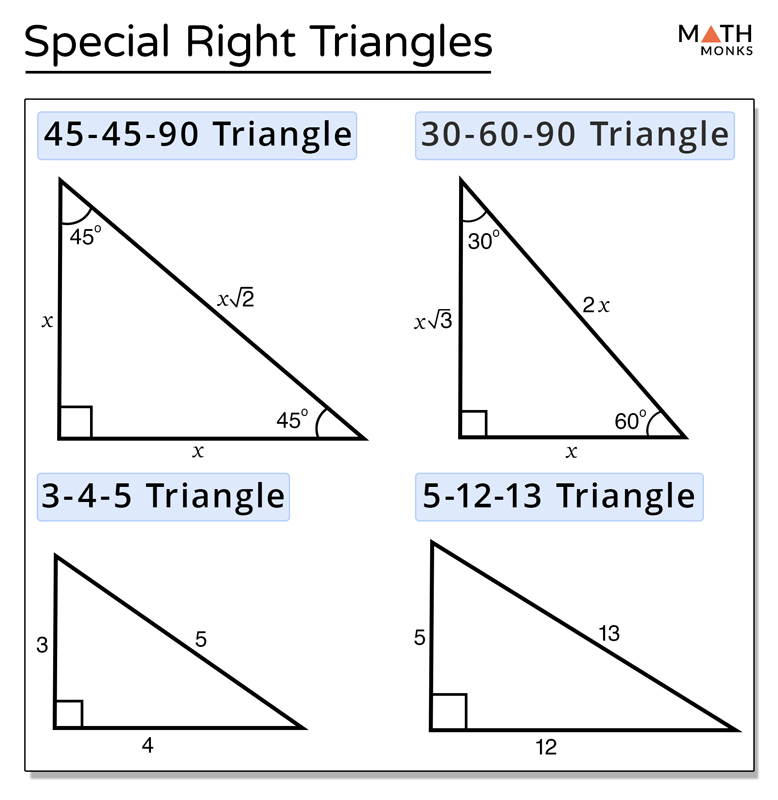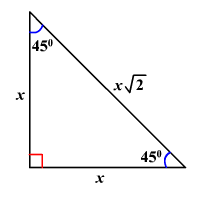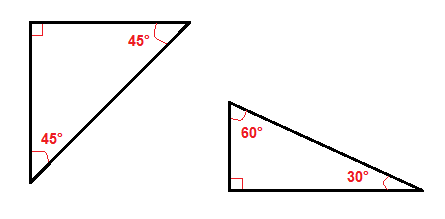
- Special right triangles formulas how to#
- Special right triangles formulas series#
- Special right triangles formulas free#
(Note the blue square: that’s the GRE's way of telling you that the angle is 90 degrees. If it is a right triangle, however, the Pythagorean theorem will surely come into play.

Never assume a triangle is a right triangle unless the problem states that it is. Let's start by defining our terms: a right triangle is one in which one of the sides equals 90 degrees. The height is a straight vertical line from the base to the vertex. To determine your base, rotate the triangle in your mind to where the longest side would be flat along the ground. To find the perimeter of a triangle, simply add up the lengths of the sides.įor area, we multiply the length of the base times the height and divide by two, or 1/2(bh). The longest side is opposite the largest angle, and the shortest side will be opposite the smallest angle. There are three different kinds of triangles: scalene (all side lengths and angles are different) isosceles (two sides and angles are the same) and equilateral (all three sides are the same length, and all angles are 60 degrees each. Triangles are polygons with three sides the sum of their interior angles add up to 180 degrees.
Special right triangles formulas how to#
Let’s talk about some of the more common shapes on the GRE geometry section and how to deal with them. Add a third line and you've got a shape called a triangle. If the two lines meet at a right angle, they are called perpendicular if the two lines run next to each other and will never meet, they're called parallel (do not assume that lines on the test are perpendicular or parallel unless the problem states that they are!). Add another line, and where the two meet is called an angle. On the GRE, all lines that appear straight are straight.
Special right triangles formulas series#
Lines are infinitely thin, infinitely long series of points. That's all geometry is: lines, angles, and shapes (it's coming back to you, isn't it?). Let's review what you'll need to know about triangles for the GRE. The bad news is that you may have forgotten a lot of what you learned in those classes. The good news is that the GRE usually doesn't test any concepts you wouldn't have learned in high school. The side across from the 90° angle is known as the hypotenuse ( Hyp.).If you're like most students preparing to take the GRE, you haven’t taken a math class in a few years. The side across from the 60° angle is known as the long leg ( L.L.). The side across from the 30° angle is known as the short leg ( S.L.).



For example, the side across from the right angle is always called the hypotenuse (you probably already knew that from the pythagorean theorem).
Special right triangles formulas free#
We even offer a free study guide that easy explains the steps easily on one page!īefore we explain how to find the missing sides, we need to give specific names to each of the sides. In this lesson you will learn the general formula for the ratios, and how to find missing sides of any 30 60 90 right triangle. Special right triangles hold many applications in both geometry and trigonometry. The reason these triangles are considered special is because of the ratios of their sides - they are always the same! These numbers represent the degree measures of the angles. The other type of special right triangle is 45-45-90. A 30-60-90 triangle is a special right triangle.


 0 kommentar(er)
0 kommentar(er)
